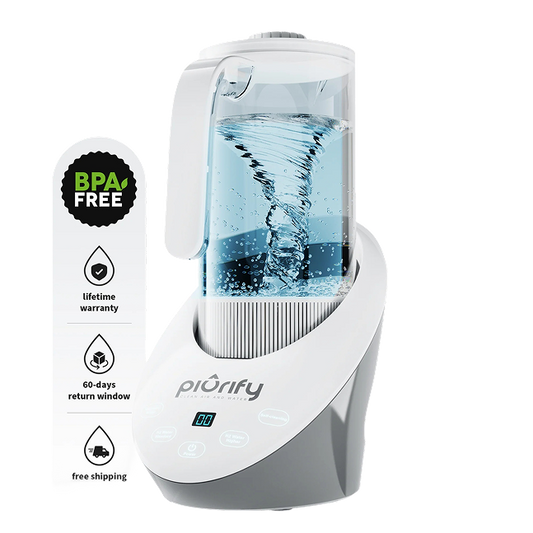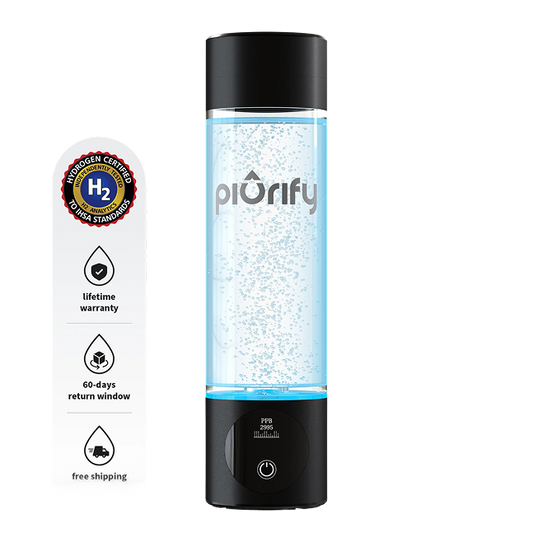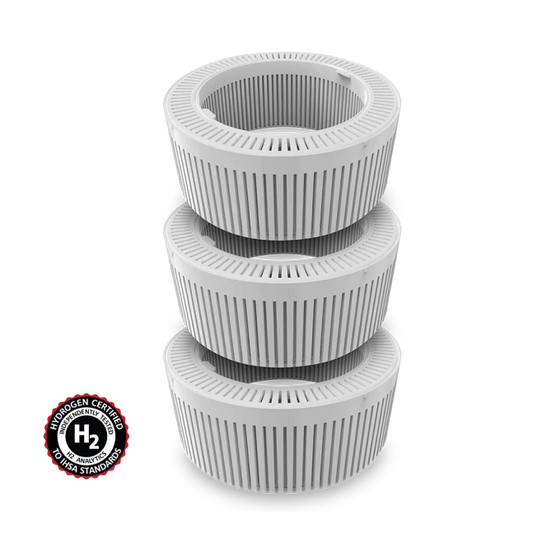How to Test Hydrogen Water
If you’ve recently purchased a hydrogen water bottle or pitcher, or you’re looking to buy one, you probably want to know how to test the hydrogen levels. To do so, proper testing is a must. But how do you text hydrogen water?
We’ve got you covered. Read on to find out how to test hydrogen water, the different methods available, and which tools provide the most accurate readings.
Why Should I Test Hydrogen Water?
Hydrogen water is just regular drinking water that contains dissolved hydrogen molecules (H₂). However, this hydrogen can dissipate over time. In bottles, for example, hydrogen water lasts 1-2 hours. However, in an open container, it may only last a few minutes. Likewise, the device you use to produce hydrogen water may not generate enough hydrogen.
This is where hydrogen water testing comes in. Testing can ensure that:
- Your hydrogen water ionizer or hydrogenator is working correctly
- You’re getting therapeutic levels (typically above 1.0 ppm)
- You can compare different devices or methods accurately
Methods for Testing Hydrogen in Water
There are several ways to measure hydrogen concentration, each with its pros and cons. Here’s a brief comparison of each before we go into more detail further down:
|
Method |
Accuracy |
Ease of Use |
Cost |
Best For |
|
Hydrogen Test Drops |
Moderate |
Very easy |
Low |
Everyday home testing |
|
ORP Meters |
Low–Moderate |
Easy |
Medium |
Quick checks, rough estimates |
|
Gas Chromatography |
Very high |
Difficult |
High |
Research or lab testing |
Here are the 3x main methods for testing hydrogen water, how they work, and the benefits and drawbacks of each:
1 – Gas Chromatography

Gas chromatography is the gold standard for accuracy. It is a laboratory method that separates and measures hydrogen gas molecules, giving the most accurate results. However, it’s not the most accessible option for at-home testing.
How gas chromatography works:
- Provide a test sample of your hydrogen water
- This gets injected into the GC injector port, and then heat is applied to release hydrogen
- A carrier gas then pushes the sample into the GC column
- Gases in the sample then get separated based on their interactions (hydrogen moves quickly as it has a low molecular weight)
- The hydrogen is then detected by a detector (e.g a Thermal Conductivity Detector (TCD) or a Pulsed Discharge Detector (PDD)
Pros:
- Highly accurate
-
Reliable scientific standard
Cons:
- Expensive (costing at least $25 per sample!)
- Not an ideal solution for home use
2 – Blue Reagent Drops (Hydrogen Test Drops)

Hydrogen test drops are one of the most common methods of testing hydrogen. A reagent solution changes colour when it reacts with dissolved hydrogen.
How hydrogen test drops work:
- Add a few drops of reagent to a water sample
- The liquid changes colour depending on the concentration of hydrogen
Pros:
- Quick and affordable
- Easy to use at home
Cons:
- Less precise than lab-grade methods
- Results can vary depending on technique
- Hydrogen gas may dissipate
The main disadvantage of using hydrogen test drops is that gas gets eliminated during this process.
When measuring, you have to move the water from the generating container to a measurement container. This can cause the hydrogen to dissipate. When you stir, even slowly, you can risk losing up to 70% of the hydrogen gas. For example, in the bottle, you may have 4000 PPB, but in the 6ml sample, you may have less than 1000 PPB.
3 – ORP (Oxidation-Reduction Potential) Meters
ORP meters are usually marketed as hydrogen testers; however, they don’t actually measure hydrogen directly. Instead, they measure the water’s electron activity, which can indicate whether your water may have dissolved hydrogen or not. It uses a metallic pin with a very reduced measurement area – which unfortunately, makes it hard to “capture” many molecules.
How ORP meters work:
- Insert the ORP meter probe into your water
-
A negative reading suggests antioxidant potential, often linked to dissolved hydrogen
Pros:
- Easy to use
-
Can provide a general indication of antioxidant strength
Cons:
- Don’t directly measure hydrogen levels
- Readings can be influenced by other substances in water
- Can be difficult to capture
The main disadvantage with ORP meters is that the nature of the product can make it difficult to capture more than 1300 PPB. It can be a great way to test if your device actually produces hydrogen, but can be difficult to measure the content after 800-900 PPB.
It uses a metalic pin, with a very reduced measurement area which makes it hard to “capture” many molecules.
Tips for Accurate Hydrogen Testing
As we’ve established, not all testing methods are 100% accurate – and results can depend on the technique you choose and timing. However, there are some best practices you can follow to increase the chances of reliable results:
- Test the water immediately after generation – hydrogen levels drop quickly over time, so test quickly to ensure more accurate readings
- Avoid any stirring or agitation – this can cause the hydrogen gas to dissipate
- Use fresh, clean containers to avoid contamination – residue from soap, detergents and minerals can affect readings, so opt for glass or tested containers
- Opt for cold water – H2 dissipates quicker in warm water due to molecule movement
- Repeat tests to ensure consistency – One test may not be enough, so take multiple readings and perform at different times to ensure consistency
- If using test drops, follow the instructions carefully for best results – Handle the drops carefully, adding the drops slowly and mixing gently to avoid bubbles
- Calibrate ORP meters regularly – If using an ORP meter, make sure it's calibrated before each use, and replace probes if you notice inconsistent readings
If you don’t think that your device is producing enough hydrogen, test water from a trusted hydrogenator (such as the Piurify Water Hydrogenator Pitcher) as a baseline. This can give you a reference point for what accurate levels should look like.
Looking to Add Hydgoen Water To Your Routine?
If you want to ensure your hydrogen water always delivers reliable results, the right device is an absolute must.
We’ve got you covered. We have two top-quality hydrogenator devices available:
Our hydrogen products offer 3x longer hydrogen retention – you can transform your regular drinking water into powerful antioxidant-rich hydration that works all day.
Got any questions about hydrogen water? Find the answer in our FAQs, or if not, contact us today.


